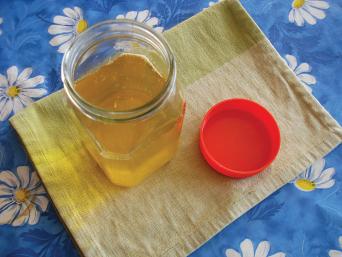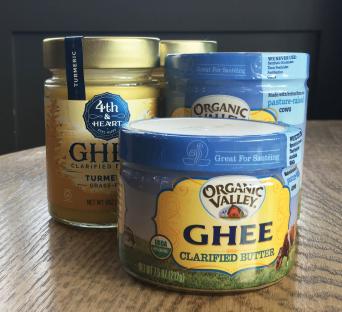
This Season, Give (or Keep) the Gift of Homemade Ghee
Ghee has become a hot new culinary ingredient, but it’s ancient. It was developed in India over 4,000 years ago to preserve butter in that hot, hot climate.
Ghee is butter that is heated and cooked for an extended period of time so that the water evaporates and the milk solids caramelize and sink to the bottom. It is then strained into jars for storage. What’s left is a delicious, nutty-tasting, spreadable butterfat that can sit on your table indefinitely; it will keep at least a year at room temperature. It is definitely not clarified butter, which is a quicker process that lacks the full flavor and keeping qualities of ghee. Don’t be fooled by labels that say otherwise.
Ghee has numerous health benefits and is virtually dairy free and paleo friendly. It contains a megadose of antioxidants, heart-healthy omega 3s, and, if you start with butter from grass-fed cows, cancer-fighting conjugated linoleic acids. It reduces inflammation in the body and helps to heal frayed gut linings. It’s loaded with Vitamins A, D, K, and E. At high heat it will not break down into free radicals; it can even be used as a natural moisturizer for hair and skin.
Ghee can be found ready-made in jars on the Co-op’s shelves or at Indian markets. I’m seeing it pop up everywhere, but it’s easy enough to make on your own and I highly recommend it. I use the method I first learned as a teen, before I started my culinary training.
Start with a pound of salted or unsalted butter, preferably from grass-fed cows. I’m partial to salted butter, because I believe the resulting ghee has more flavor. Place the butter in a heavy-bottomed pot; it should not be too full. There should be ample head space because the butter may foam up initially. Cast iron is too dark, you will not be able to judge the degree of caramelization.
On a back burner, melt the butter over medium heat, then turn the heat down to the lowest setting; do not stir the butter at any time. Let it cook slowly for about 3-½ hours or until the butter is clear and the milk solids are well browned and have mostly settled on the bottom. Some people prefer to do this in a low oven for six hours instead of on the stovetop; I’d probably forget about it.
You can turn the heat up a little if the milk solids are not browning, but be sure to watch it more carefully. You can let the milk solids brown deeply, enhancing the nutty caramel flavors, but it is possible to go too far and burn them.
Turn off the heat and let the butter cool about five minutes, then strain it through a mesh strainer lined with unbleached paper towel into a quart-sized glass measuring cup. Pour the clear butterfat into seriously – clean canning or salvaged jars; it should yield around 13 ounces.
If the ghee has cooled so much that you can’t strain it, gently reheat it. Let it cool to room temperature before putting on the lids. It will semi-solidify and turn yellow. Different brands of butter will yield different shades of yellow.
You can eat the delicious caramelized bits at the bottom if you don’t mind the dairy. Their flavor is intense spooned onto cooked rice or in baking. My gut prefers to stay dairy free, so I reluctantly discard them.
Use your ghee as you would regular butter. Spread it on toast, rice, or a baked potato. With a high smoking point of 500°, it is excellent for sautéing vegetables, chicken, or anything. It’s easy to mix into your pancake batter.
When chilled, ghee can be used in biscuits or pie crust, or slightly chilled for cakes and cookies. Standard butter is roughly 20% water, salt and milk solids and 80% fat, but ghee is 100% fat. Ghee will function in baking more like shortening, which is also 100% fat. Substituting ghee for butter may require some adjustment for the reduction in liquid; you may have to reduce the fat a bit and increase the liquids. It’s an experiment every time.
Ghee can be flavored either by slow-cooking it with toasted spices like cardamom, mustard seeds, cumin seeds, chili peppers, or raw garlic cloves, or by mixing in flavorings after it has cooled and solidified. Honey ghee, made with equal quantities of raw creamed honey and ghee with a pinch of sea salt, is delightful on cornbread or pancakes. Raw flavorings like fresh garlic and herbs will not keep safely at room temperature, so mix only what you will use up. Have fun experimenting!
Dianne Dillman is a food writer, professional chef, and Weavers Way working member.

